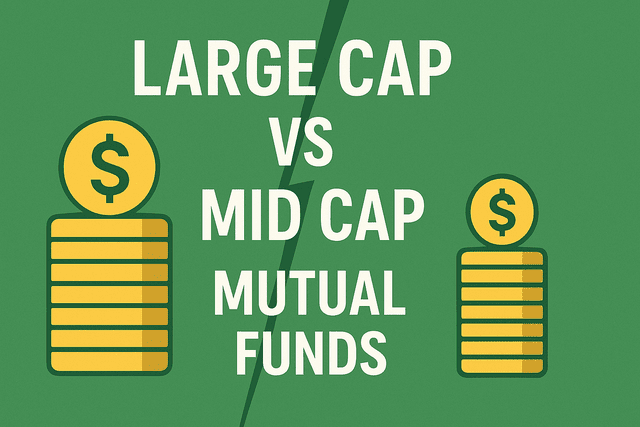
Comparing Large Cap vs Mid Cap Mutual Funds
Table of Content
- 1 Decoding the Investment League Tables: Market Cap Rankings Explained
- 2 The Blue-Chip Fortress: Why Large Caps Are Every Conservative Investor’s Best Friend
- 3 The Goldilocks Zone of Investing: Mid Cap Funds That Are Just Right
- 4 The Investment Seesaw: Understanding the Risk-Return Tango
- 5 Your Digital Crystal Ball: Harnessing Technology for Smarter Investment Choices
Decoding the Investment League Tables: Market Cap Rankings Explained
In the complex land of equity investments it is most important to know the basic variances between large cap mutual funds and mid cap mutual funds when it comes to creating balanced portfolio. Both types of mutual funds are particular investment wisdom and have their benefits and drawbacks that can sharply influence your wealth-creation process.
The market capitalization of large-cap sizes 1-100 and mid-cap 101-250, which gives a stark contrast between market positioning and investments nature. This ranking system allows the investor to know where to have his/her money spent and the sort of growth path of his/her investments.
The Blue-Chip Fortress: Why Large Caps Are Every Conservative Investor’s Best Friend
The large cap mutual funds are targeted at investing in already established market leaders who have already tested their capabilities by years of stabilized performance. Large cap mutual funds are open- ended equity mutual funds that invest a great part of their resources, i.e., at least 80 percent of their investments, usually in business organizations with a market capitalization of over thousands of crores. The investment vehicles provide a sense of security that is favorable to conservative investors who want smooth profits.
Large cap funds are attractive to the extent that they are both stable and have growth trends that can be predicted. Such firms usually control their relevant industries, and have already achieved firm market status which makes them less prone to a sharp rise in demand or market tremor.
To others like investors who are mainly concerned with capital protection and modest growth, large cap funds are the best way to go. These renowned companies also offer additional prospect of income generation through their dividend-paying capacity, which is further appealing to anyone who would prefer recurring amounts of cash incomes derived out of the investments.
The Goldilocks Zone of Investing: Mid Cap Funds That Are Just Right
Mid cap mutual funds are in golden middle between stability and the growth potential that can be devastating. Such capital is invested in organizations that have ascended out of the first start up but have not attained the maturity of big cap mammoths. This position can enable them to garner substantial growth opportunities at the same time have a superior business fundamentals in view of smaller companies.
The main appeal of the mid cap funds lies on the fact that they have a better growth potential in good market conditions. Mid cap mutual funds are one of the best investments to have in 2025 in India due to the current status and future popularity in the market.
Such firms may be in new applications or be the coming generation of the blue-chip company, offering an investor a position in their blue-chip companies at current prices.
The Investment Seesaw: Understanding the Risk-Return Tango
The risk-reward profile establishes the greatest difference between these two category of mutual funds. The big-cap mutual funds can be less prone to the fluctuations in the market since they focus on big and strong established firms. Associated with this stability is the trade off of possible less returns than that of their mid cap counterparts.
The closing level of the mid cap funds is high in growth and associated with higher instability and exposure to the market. These funds tend to perform well during bull markets and underperform large cap funds during the down period as well, sharp corrections may occur. In making such a decision, it is crucial to understand your risk tolerance because the emotional and financial costs of volatility can radically differ across the profiles of investors.
Your Digital Crystal Ball: Harnessing Technology for Smarter Investment Choices
Technological tools now enable modern investment planning to achieve a lot in providing a picture of a long-term situation. Mutual fund sip calculator is a very useful tool to compare how each kind of mutual fund may affect your wealth creation based on different time horizons. The calculators will make you see the compounding effect and come up with data-informed decisions concerning your investment distribution.
In search of investment opportunities, websites such as Angelone offer detailed tools and facilities that enable a potential investor to research and scrutinize types of funds and their past performance trends.
The valuation of market cap categories to their financial aims and risk levels allows an investor to visualize varying scenarios more clearly to enable them make better decisions when investing that can have a profound effect on the outcomes of wealth creation in future.


